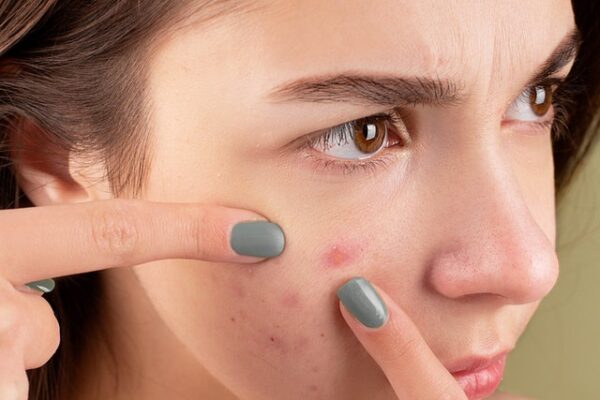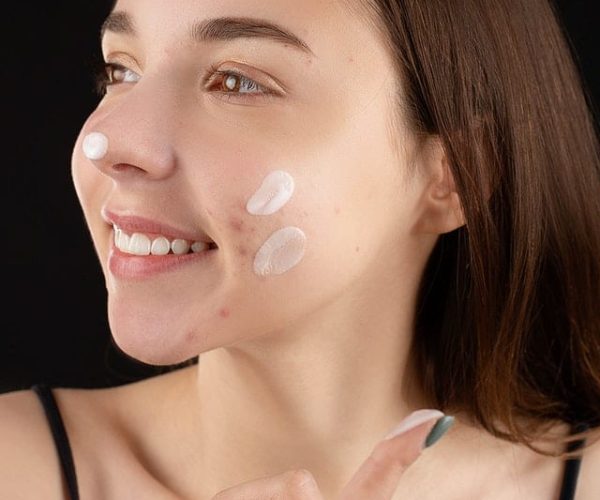Have a question?
New York Locations
Book Now
Have a question?
Book an appointment
4 New York Locations
Menu
Have a question?
New York Locations
A common skin condition, acne is an inflammatory disease that occurs when dead skin cells and sebum block the pores, resulting in pimples. Acne scars can be found on the face, back and chest. In severe cases, it forms cysts and nodules that lead to scarring.
Acne is one of the most common skin problems as it affects nearly 80% of people between the ages of 11 and 30. Even when healed, it can still leave visible marks behind, making patients anxious to find a treatment to get rid of acne scars. Although harmless, acne scarring can cause psychological stress in patients because of its noticeable appearance, leading to low-self esteem and poor self-image in some cases. Fortunately, there are a few treatments, products, and procedures that can help remove or minimize the look of acne marks.


Among the products that help with getting rid of small or minimal acne scars, these two are the most efficient:
Retinoids: Topical retinoids may help get rid of acne scars. In the journal Dermatology and Therapy, it’s stated that retinoids block inflammation, reduce acne lesions and accelerate cell regeneration. Retinoids could also help lighten hyperpigmented acne scars, including improving acne scarring on black skin and other darker skin tones.
Salicylic acid: This compound is commonly found as an ingredient in acne skin care products. It helps clean dirt, debris, and dead skin cells that tend to clog the skin. It can also reduce redness and swelling, which may help lessen the appearance of scarring.
For severe acne scarring, treatment may need to be done by a medical professional to achieve the best cosmetic result. If you are searching for acne scars treatment in New York, request a consultation with Doctor Roya to learn about your specific skin care needs and the various types of acne scars treatment available.

Preventing acne scarring is best achieved by taking care of the skin when acne occurs. However, acne scars can be fixed with various types of acne scarring treatments. Doctor Roya Hassad performs acne scars removal in NY with a plethora of acne scar procedures.
Skin is the largest organ in the body, which comprises three layers of tissue. Your skin protects your insides from the sun and UV rays. Any area with sebaceous glands is prone to acne, which can lead to various types of acne scars. Acne scarring can be found anywhere on the body, including the face, back or chest. But what causes the scarring in the first place?

Scarring occurs when pores swell, creating a breakdown in their wall. Sometimes the contents of the blemishes spill into the surrounding tissue and cause deeper acne scars. The skin reacts and tries to repair the acne lesion by forming new collagen fibers which, in some cases, is what causes raised tissue at the surface of the skin as it ultimately produced too much collagen. In other cases, the blemishes become inflamed, leading to a loss of facial tissue that creates an indentation when the scars appear.
How to reduce scarring from acne or how to get rid of acne scarring altogether depends on what type of acne scars are visible. There are various scars treatments for removing acne scars. Contact Doctor Roya for information on laser treatments available for acne scars, how much they cost as well as other acne scar removal options in New York.
Before we get into treatment options, let’s look at the different types of acne scarring to help you determine what is the best treatment for your acne scars.
There are multiple types of acne that leave scarring on the skin. Most people have a combination of different scar types. The question, “Is acne scarring permanent?” is easily answered—it doesn’t have to be. Each type of acne scars can be treated with success to achieve scar removal.
Severe acne leading to cysts and nodules is the most likely to leave visible, atrophic, or depressed scarring which patients often seek to reduce:
Ice pick scars: This type of acne scar looks as if an object with a sharp, narrow tip (like an ice pick, hence then name) had made a hole in the skin. Although small, they are also deep and create “holes” or “pits”, usually on the cheeks and/or the sides on the face.
Rolling acne scars: Typically found on the lower cheeks and jaw where the skin is usually thicker, the indentions have sloping edges that make the skin look wavy and uneven. What causes this particular type of scarring are fibers that connect the tissue, pulling it down, making it appear indented.
Boxcar scars: Also found on the cheeks and jaw, these scars appear when the skin doesn’t produce enough collagen to heal the lesions left by inflammatory acne. The marks then get deeper as they sink into the skin. This type of acne scarring looks like “craters”, rounded and deep. Their defined, sharper edges can make treating them more challenging.
If you are looking for acne scar removal in New York, Doctor Roya is an expert in all types of treatments. For various types of acne scarring and acne marks, it’s imperative to learn about the correct chemicals, treatments, and scar procedures to help determine which one is appropriate for your particular case. As mentioned earlier, treatment can vary and what gets rid of acne scars depends on the type and the severity of the scarring.
Laser treatments, chemical peels, and microneedling are all types of acne scar removal treatment. Meet Doctor Roya for a consultation with a medical expert to find out what treatment is best for you.
Here are different techniques to remove, heal and reduce scarring:
Chemical peels: This can be used to treat various types of acne scars. It helps with acne scarring removal as it peels off the outer layers of skin. However, it shouldn’t be used for very deep scars.
Dermabrasion: Mainly targeted at boxcar scars, this treatment works by “sanding down” the top layers of skin, making the scars shallower. This technique is a type of resurfacing of the skin.
Dermal fillers: Various substances such as hyaluronic acid or calcium hydroxyapatite are injected into the skin to remove acne scars.

Laser therapy: This laser treatment uses a high-energy light that removes the outer layers of skin and stimulates collagen production, repairing the marks left from acne. This acne scarring laser treatment can help address a large area of the skin.
Microneedling: This technique creates tiny injuries with needles across the acne scars and helps with collagen production, stimulating the healing process.
Subcision: It’s possible to remove acne scarring with this technique. It breaks up scar tissue by cutting the connective fibers and makes the indention raise up, instead of being pulled down.
TCA Cross (chemical reconstruction of skin scars): Applying TCA cross onto a sunken scar helps the skin create extra collagen that can help raise it up, making it less noticeable.
The answer to the question, “Does acne scarring go away?” is fairly straight forward—with the correct treatment, it can. No matter what type of acne scars you may have, there is always a treatment available. Soon the scars will be a thing of the past, and smooth, glowing skin will replace them.



Anyone with visual scarring that’s looking for scar removal in New York is a candidate for treatment. A consultation will give you all the information you need to determine what treatment is best for you to help remove acne scars.
Dr. Roya performs treatments for scar removal in NY in 4 different locations—Manhattan, Long Island and Queens. Contact Doctor Roya today for a consultation.
12 Bond St, Unit C2 Great Neck NY 11021
895 Park Ave, Suite 1 B, New York, NY 10075
41-02 75th Street First floor Elmhurst, NY 11373
109 East 36th Street, NY 10016